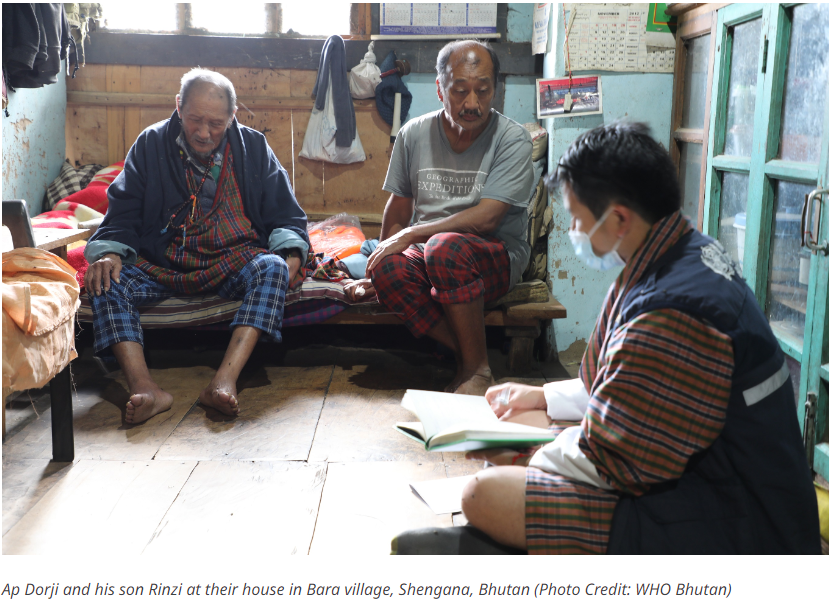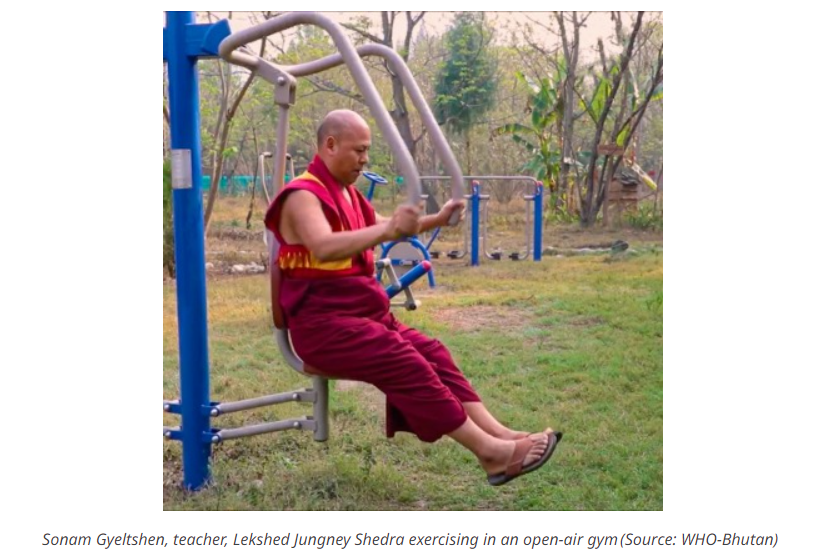World Health Organization
From Mandate to Implementation: Operationalizing National Multisectoral Governance for NCDs in Kuwait
Multisectoral Action
17 Dec 2025
World Health Organization | 21 Sep 2022
Noncommunicable diseases (NCDs) pose a serious health problem and are responsible for 64 percent of all deaths in the WHO South-East Asia Region impacting social and economic development. In Bhutan, changing lifestyle and dietary habits have been the chief factor driving the increase in NCDs, which account for 69 percent of all deaths.
In 2014, combating NCDs was identified as a Flagship Priority by Dr Poonam Khetrapal Singh when she assumed charge as Regional Director. Since then, countries of the Region have been making sustained efforts to reduce the incidence of NCDs by addressing the prevalence of risk factors.
As part of Bhutan’s Gross National Happiness (GNH), which prioritizes the well-being and happiness of people over conventional socioeconomic indicators, the country has taken several innovative measures to combat NCDs and save lives.
Bhutan was the first country in the WHO South-East Asia Region to adopt the WHO package of essential noncommunicable (PEN) disease interventions for primary health care in low-resource settings in 2009 and scaled it up nationwide in 2013–2014. In 2015, Bhutan launched the Multisectoral National Action Plan for Prevention and Control of Noncommunicable Diseases.
A clinical audit of PEN implementation conducted in 2016 highlighted several gaps in care for hypertension, diabetes and other chronic diseases. These included little follow-up by health-care facilities and medicine refills not being monitored carefully, often leaving patients to manage their condition alone, leading to poor results.
To address gaps and shortcomings, the Ministry of Health with support from WHO in 2018 piloted the Service with Care and Compassion Initiative (SCCI) in four dzongkhags (districts) of Punakha, Tsirang, Wangdue and Zhemgang.
Following its successful implementation, the ministry during the Biennial Health Conference in 2019, prioritized to scale it up to all 20 districts in the country.
The approaches employed by this model are known as 7R: robust team building, reach out to homebound services, refill of medicines, recall and reminders, responsive referrals, reliable and people-centered laboratory diagnosis, and real time monitoring and supportive supervision and 3C: comprehensive, collaborative and continuum of care.

Rinzi Dorji breaks out in a smile as he recalls the life-altering change that health care at home has meant for him and his father. The 65-year-old farmer from Bara village, Shengana, Bhutan has chronic diabetes and for years faced hardships in getting regular medicine refills and health care for himself and his 95-year-old father, Ap Dorji, who has visual and hearing impairments.
Then in 2018, the Service with Care and Compassion initiative (SCCI) was launched. An important part of this initiative involves screening for NCDs whenever a person visits a health facility. This helps identify any problems early on and timely intervention. Regular follow-up of patients, ease of getting medication and home-bound care are just a few of the innovative features of the initiative.
For Rinzi, Ap and many others, this has meant getting medicines and health care is no longer an ordeal. Earlier on there was no coordination among health facilities to gather forms III and II medicines for patients, often leading to inconvenience.
To ensure continuity of medication, a robust system was set up as part of the SCCI, with a designated focal person collecting prescriptions at the Jigme Dorji Wangchuck National Referral Hospital (JDWNRH) from all the districts and sending these to the pharmacists. The pharmacists at district levels then call the in-charges from the primary health centres (PHCs) to collect medicines for the patients, which are line-listed and due for dispensing.
Patients who are unable to come to the PHCs are visited as part of home care. Medical teams also follow up on their progress and screen for any problems when conducting home-care visits and regularly follow up with patients about their condition and reminders about their medication.
‘Home care has benefited me and my mother and I am very thankful for the regular visits by the health assistant,’ says 42-year-old Aum Zam the prime caregiver for her 76-year old mother who has been bed-ridden due to a spinal injury from a fall five years ago.
The SCCI is founded on a system-based improvement approach in that health workers support each other to address emerging challenges and fill any gaps in NCD services and practices of patient care. A team led by a doctor based in the district hospital provides mentoring and leadership to two PHCs. Every 6 months, the mentoring team visits the PHCs to carry out supportive supervision. A standard checklist is used to document successes and challenges being faced by the PHCs.
The district mentoring teams use a combination of onsite and virtual modes of interaction and employ social media platforms to coach and discuss cases and referrals with the staff of PHCs.
‘The PHC teams are being mentored in person, as well as through virtual platforms. The team from the district hospital mentors the PHC on essential clinical care services, while the district health office provides mentoring on reporting systems. This has resulted in improved clinical care and early referral of pregnant women with expected complications and patients with uncontrolled hypertension and diabetes.’ – Dr Tshewang Gyeltshen, Tsirang Hospital, Bhutan
The WHO also supports regular joint monitoring and supportive supervision by focal persons from Ministry of Health, Gross National Happiness Commission and WHO to assess the gaps and improve the implementation of SCCI in the districts.
Apart from benefiting beneficiaries, the SCCI has been a motivating factor for health professionals. At the primary care level, there has been an improvement in the redistribution of tasks and task-sharing. Health assistants (HAs) at the PHCs conduct screening, initiate treatment, and counsel and educate patients.
Patient histories and any challenges are discussed at the district hospital level. This has led to an overall change in approach to patient care at the district level and the work environment has become more positive. It has also helped make the health system more resilient.
Increased interaction, including home-care visits by HAs, has further helped the health-care professionals gain the trust and confidence of patients and the community and increase community-based support and cooperation.
‘Personally, I am very satisfied with the PEN HEARTS model as it helps me work in a more systematic way. In addition, this concept ensures that the patient is at the centre of everything. One example is that now I call up the doctor and fix an appointment before sending the patient for further consultation or treatment to the hospital at Yebilaptsa. This way, patients are able to meet the doctor on time and it saves a lot of trouble.’ – Ms Krishna Maya Monger, HA Tshaidang PHC, Zhemgang.
To review and improve the effective delivery of NCD services, as a part of cohort control rates and coverage rates for hypertension, brief interventions, and home-bound care are computed for all health facilities, including PHCs, on a quarterly/annual basis.
The PEN focal person at the district level reviews these reports and submits them to the district health officer. These reports are then submitted to the NCD programme division at the Ministry of Health. The NCD programme division provides written feedback on the reports. This has gone a long way towards improving health services.
Insufficient physical activity and sedentary behaviour is a leading risk factor for NCD-related mortality and the rising prevalence of NCDs. Globally, one in four adults do not meet the global recommended levels of physical activity and up to 5 million deaths a year could be averted if the global population was more active.
To encourage people to participate in physical activities, the Ministry of Health of Bhutan in 2015 with support from WHO established outdoor gyms at various locations in all 20 districts of the country.
Dr Rui Paulo De Jesus, WHO Representative to Bhutan, says: ‘NCDs are preventable. WHO consistently works with the Royal Government of Bhutan, Ministry of Health and other stakeholders to raise awareness of Bhutanese on prevention of NCDs including promotion of physical activity, healthy diet, tobacco-free initiative as well as avoiding the harmful use of alcohol. To promote physical activity, WHO supported the establishment of open-air gym facilities across the country.’

‘In order to protect our monks from noncommunicable diseases, we must have physical activities. Unlike others, monks don’t have the time to go for morning run, to play football or basketball. The open air gym is convenient because we can exercise regularly between our studies. Health workers wh visit our monastic school to screen us for NCDs have observed visible improvements in our health and encourage us to continue using the open air gym,’ said Sonam Gyeltshen, Teacher, Lekshed Jungney Shedra.
While the open-air gyms have opened up avenues for people to exercise and stay healthy, they face challenges of regular maintenance. Though physiotherapist technicians were trained in the past to take care of the machines, it was noted that they did not have adequate tools and parts for maintenance. Addressing these challenges will restore and add to the available measures to combat NCDs.
While the SCCI has made an impact, it has also led to an increase in the workload of health-care professionals. Increased frequency of attending home-bound care, collecting medicine refills from hospitals, and increased frequency to attend to calls in the community. Though the initial phase of this intervention may demand additional attention and efforts, the programme may consider assessing the amount of workload due to this initiative within the context of the overall workload.
The integration of the SCCI into primary health care as part of a routine programme instead of implementation in project mode would help further realize benefits, document gains and enable the exchange of best practices among health-care professionals. Efforts should be made to include SCCI modules as part of university curricula to ensure its long-term sustainability
To reduce the burden of vertical reporting and ease of listing and tracking medicine refills, home-bound visits, quarterly reporting, recalling and reminding patients, the programme may work on integrating these with the Health Management Information System (HIMS) datasets.
Health, happiness and well-being are closely linked. By zeroing in on the main risk factors contributing to NCDs and taking steps by innovating, sustaining and accelerating action to prevent and treat NCDs with a people-centric approach, Bhutan has set an example of how to make people healthier and happier by beating NCDs.
Addressing challenges will further strengthen measures to combat NCDs and accelerate progress towards Sustainable Development Agenda (SDG 3.4) of reducing premature deaths from NCDs by one third by 2030 and promoting well-being for all at all ages.